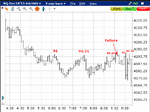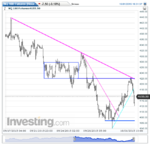dbphoenix
Guest Author
- Messages
- 6,954
- Likes
- 1,266
Contrary to a commonly-held belief among beginning traders, journals are records of journeys. They may include charts, or not. They may eventually include trades, but that comes later. Or should, if trades are included at all. But they needn't be. Logging trades is the purpose of a trading log, not necessarily a trading journal.
My original thread (see my signature) explained the gist of the SLA/AMT rather quickly. And while questions and comments have been welcome (and sincere questions and comments will be continue to be welcome), nothing is gained by going on and on and on about it, particularly when a thread becomes so long that nobody wants to read it and the repetition begins. And when the signal-to-noise ratio begins to shift toward the noise end of the spectrum, coincident with the arrival of those who have no interest in the SLA, much less an understanding of it, it's time to focus on those who possess such an interest and seek such understanding.
I posted the following to the original thread. It should be self-explanatory to those who've read the material, much less my book, but that doesn't mean that there are no questions to be asked nor nothing to be discussed. Those who are interested in participating are welcome to contact me to have their names put on the list of those who have access (shades of Studio 54).
********************
From the attic:
If one understands that price and its movement are independent of however we choose to display them, then he pretty much has it. To me, this is a given, but there are those to whom the concept of the continuous flow of price makes no sense. They will see the market very differently.
(Coincidentally, those who do not grasp the continuous nature of price flow often also consider displays in smaller bar intervals to be "noise", i.e., meaningless, random, irrelevant.)
Whether one displays price in time bars, tick bars, range bars, constant volume bars, point & figure, dots, lines, histograms or musical notes is of no concern to price. As long as something is being traded, it's going to do what it's going to do, even if one chooses not to "print" it at all. Finding reasonable and objective explanations of each of these options can be problematic since those who offer the explanations often feel as though whichever option they've selected provides the answer they've been looking for, and if only everyone chose the same option, everything would be clear and everyone's problems would be over. Would that it were so easy.
One must remember that the more obvious the movement, however it is displayed, the more people there are who will see it. Therefore, if one trades EOD using daily bars, he's going to have an awful lot of company. Everybody sees that. Everybody. But if he's trading 5-second bars, not so much. Therefore, he's more likely to take quick profits because the trading crowd he hangs around with is generally not in this for the long haul.
However, if he locates a point where all these waves intersect, he can use that 5-second chart to enter a position and have the combined forces of everyone who's looking at a daily chart and hourly and 15m and so forth behind him, providing the confidence he may need to give the trade a little bit of room, a little bit of time to "ripen", rather than be shaken out of what will be a very profitable trade by a momentary twitch that plays only a small part in the grander scheme of things.
My original thread (see my signature) explained the gist of the SLA/AMT rather quickly. And while questions and comments have been welcome (and sincere questions and comments will be continue to be welcome), nothing is gained by going on and on and on about it, particularly when a thread becomes so long that nobody wants to read it and the repetition begins. And when the signal-to-noise ratio begins to shift toward the noise end of the spectrum, coincident with the arrival of those who have no interest in the SLA, much less an understanding of it, it's time to focus on those who possess such an interest and seek such understanding.
I posted the following to the original thread. It should be self-explanatory to those who've read the material, much less my book, but that doesn't mean that there are no questions to be asked nor nothing to be discussed. Those who are interested in participating are welcome to contact me to have their names put on the list of those who have access (shades of Studio 54).
********************
From the attic:
If one understands that price and its movement are independent of however we choose to display them, then he pretty much has it. To me, this is a given, but there are those to whom the concept of the continuous flow of price makes no sense. They will see the market very differently.
(Coincidentally, those who do not grasp the continuous nature of price flow often also consider displays in smaller bar intervals to be "noise", i.e., meaningless, random, irrelevant.)
Whether one displays price in time bars, tick bars, range bars, constant volume bars, point & figure, dots, lines, histograms or musical notes is of no concern to price. As long as something is being traded, it's going to do what it's going to do, even if one chooses not to "print" it at all. Finding reasonable and objective explanations of each of these options can be problematic since those who offer the explanations often feel as though whichever option they've selected provides the answer they've been looking for, and if only everyone chose the same option, everything would be clear and everyone's problems would be over. Would that it were so easy.
One must remember that the more obvious the movement, however it is displayed, the more people there are who will see it. Therefore, if one trades EOD using daily bars, he's going to have an awful lot of company. Everybody sees that. Everybody. But if he's trading 5-second bars, not so much. Therefore, he's more likely to take quick profits because the trading crowd he hangs around with is generally not in this for the long haul.
However, if he locates a point where all these waves intersect, he can use that 5-second chart to enter a position and have the combined forces of everyone who's looking at a daily chart and hourly and 15m and so forth behind him, providing the confidence he may need to give the trade a little bit of room, a little bit of time to "ripen", rather than be shaken out of what will be a very profitable trade by a momentary twitch that plays only a small part in the grander scheme of things.



